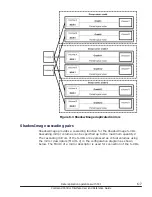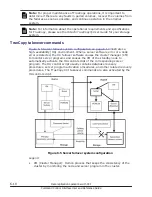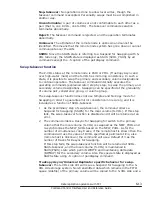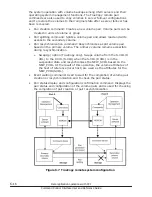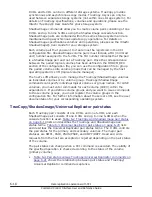
P-VOL and S-VOL can be in different storage systems. TrueCopy provides
synchronous and asynchronous copy modes. TrueCopy Async can only be
used between separate storage systems (not within one storage system). For
details on TrueCopy specifications, volumes and operations, please see the
Hitachi TrueCopy® User Guide
for your storage system.
ShadowImage commands allow you to create volume pairs consisting of one
P-VOL and up to nine S-VOLs using the ShadowImage cascade function.
ShadowImage pairs are contained within the same storage system and are
maintained using asynchronous update copy operations. For details on
ShadowImage specifications volumes and operations, please see the
Hitachi
ShadowImage® User Guide
for your storage system.
Each volume pair that you want to create must be registered in the CCI
configuration file. ShadowImage volume pairs must include a MU (mirrored
unit) number assigned to the S-VOL. The MU number indicates that the pair
is a ShadowImage pair and not a TrueCopy pair. Once the correspondence
between the paired logical volumes has been defined in the HORCM_DEV
section of the configuration file, you can use the configuration file to group
the paired volumes into volume groups that can be managed by the host
operating system's LVM (logical volume manager).
The host's LVM allows you to manage the TrueCopy/ShadowImage volumes
as individual volumes or by volume group. TrueCopy/ShadowImage
commands can specify individual logical volumes or group names. For LUSE
volumes, you must enter commands for each volume (LDEV) within the
expanded LU. If you define volume groups and you want to issue commands
to those volume groups, you must register the volume groups in the
configuration file. For further information about the server LVM, see the user
documentation for your corresponding operating system.
TrueCopy/ShadowImage/Universal Replicator pair status
Each TrueCopy pair consists of one P-VOL and one S-VOL, and each
ShadowImage pair consists of one P-VOL and up to nine S-VOLs when the
cascade function is used.
Table 6-2 TrueCopy and ShadowImage pair status
lists and describes the TrueCopy and ShadowImage pair
status terms.
Table 6-3 Universal Replicator pair status on page 6-20
and describes the Universal Replicator pair status terms. The P-VOL controls
the pair status for the primary and secondary volumes. The major pair
statuses are SMPL, PAIR, PSUS/PSUE, and COPY/RCPY. Read and write
requests from the host are accepted or rejected depending on the pair status
of the volume.
The pair status can change when a CCI command is executed. The validity of
the specified operation is checked according to the status of the volume
(primary volume).
•
Table 6-4 Pair status versus TrueCopy/Universal Replicator commands on
shows the relationship between pair status and TrueCopy/
Universal Replicator command acceptance.
6-18
Data replication operations with CCI
Command Control Interface User and Reference Guide
Summary of Contents for HUS VM
Page 10: ...x Command Control Interface User and Reference Guide ...
Page 18: ...xviii Preface Command Control Interface User and Reference Guide ...
Page 78: ...2 50 CCI software environment Command Control Interface User and Reference Guide ...
Page 154: ...4 8 Starting up CCI Command Control Interface User and Reference Guide ...
Page 191: ...Provisioning operations with CCI 5 37 Command Control Interface User and Reference Guide ...
Page 280: ...6 56 Data replication operations with CCI Command Control Interface User and Reference Guide ...
Page 286: ...6 62 Data replication operations with CCI Command Control Interface User and Reference Guide ...
Page 302: ...7 16 Data protection operations with CCI Command Control Interface User and Reference Guide ...
Page 324: ...8 22 Examples of using CCI commands Command Control Interface User and Reference Guide ...
Page 524: ...9 200 Troubleshooting Command Control Interface User and Reference Guide ...
Page 529: ...Command Control Interface User and Reference Guide ...




